A lucky escape in the Grand Harbour at Valletta, Malta, in 1924
Led to the founding of the charity H10, now known as Veterans Aid
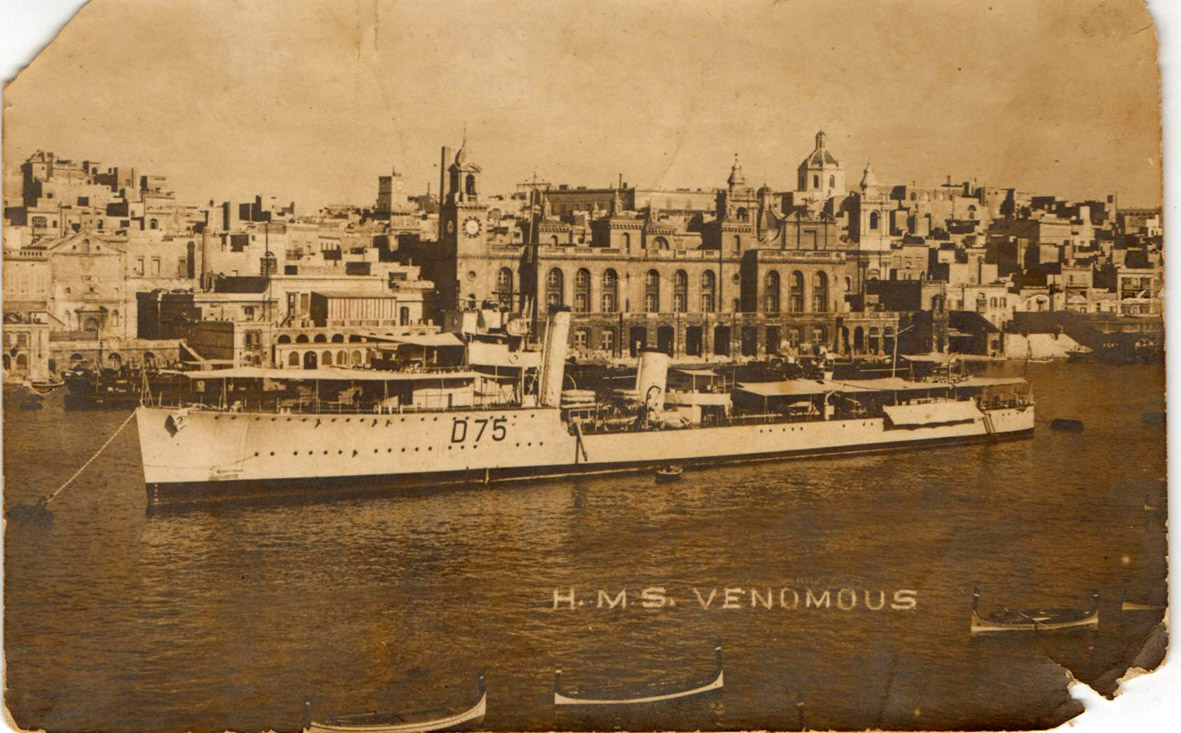
Ladies and gentlemen strolling along the ramparts overlooking the Grand Harbour on a Sunday afternoon in November 1924 would have had a grandstand view of events as HMS Venomous rammed and sunk a motor boat taking Major Charles Huggins and his wife and eleven year old son to the cruiser HMS Calypso for afternoon tea.
HMS Venomous with Lt Cdr Donal Scott McGrath RN in command left Gibraltar on Thursday 30 October at 1924 and entered the Grand Harbour at Valetta on the afternoon of Sunday 2 November. A brief entry in the Logbook recorded what happened:
1630 Slow course as req. for entering harbour
1634 ˝ Rammed & sank MB belonging to “Calypso”. All hands saved.
1650 Secured alongside “Woolston” at Canteen Wharf
An entry in the log book of HMS Calypso, a light cruiser of the Mediterranean Fleet, for 2 November 1924 reads:
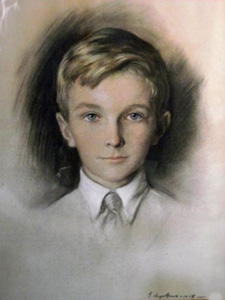
 The four
passengers were Major Charles Gilbert Dingwall Huggins (1882-1965), second-in-command of the Gordon
Highlanders stationed at Malta, his wife Gwendolen Isla Huggins, neé Brougham (1892-1974), their eleven
year old son Ulric, and Lieutenant (later Captain) Cronyn RN, who had
invited the Huggins
family to tea on Calypso. The
passengers embarked at Custom House Steps, Valletta, the adults
sheltering from the hot sun under the old fashioned painted canopy.
The four
passengers were Major Charles Gilbert Dingwall Huggins (1882-1965), second-in-command of the Gordon
Highlanders stationed at Malta, his wife Gwendolen Isla Huggins, neé Brougham (1892-1974), their eleven
year old son Ulric, and Lieutenant (later Captain) Cronyn RN, who had
invited the Huggins
family to tea on Calypso. The
passengers embarked at Custom House Steps, Valletta, the adults
sheltering from the hot sun under the old fashioned painted canopy.
While crossing the Grand Harbour, the boat heeled sharply as HMS Venomous approached. Lieutenant Cronyn moved quickly to the stern sheets and saw immediately that disaster threatened. He shouted a warning to Major and Mrs Huggins and threw Ulric overboard as the boat was rammed amidships, turned over and sank.
Ulric was carried clear of the destroyer by its bow wave and supported by the Gordon kilt he was wearing. Lieutenant Cronyn was sucked under the vessel but being a strong swimmer got clear, and always remembered the horrified look of the first lieutenant on the bridge of Venomous. Major Huggins went down with the boat but surfaced in a near drowning condition. The cox’n and his stoker jumped overboard and swam clear. This fine portrait of Ulric was painted in 1925.
HMS Umpire, a modified R-Class destroyer with the pennant number H10 on its side (see photograph below), lowered its boat and rescued passengers and crew.
Mrs Huggins failed to get clear of the canopy and found herself trapped in the wreckage but able to breathe due to an air-pocket in a bulge of the canopy. She freed her leg from an obstruction; launched herself clear and saw blackness give way to violet, then to blue and finally a green diffused light before shooting out of the water waist high into the brightness of day. A cry went up “there she is” and she was quickly hauled out of the water. She had been at the bottom of the harbour in 12 fathoms for about 10 minutes. Remarkably she suffered no ill-effects from her ordeal and insisted on walking up the companionway of Calypso unassisted.
The most detailed account of the near fatal accident was that given in The Daily Malta Chronicle
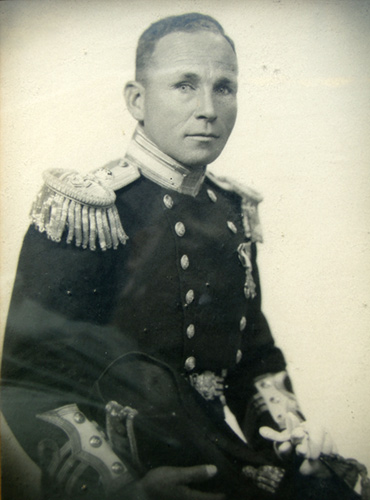 The young wife of Lt Cdr Donal Scott McGrath RN (on left, 1915), the CO of HMS Venomous,
pasted this press cutting into the pages of her scrapbook about the
naval career of her husband. It was sent to me by their grandson in
Australia.
The young wife of Lt Cdr Donal Scott McGrath RN (on left, 1915), the CO of HMS Venomous,
pasted this press cutting into the pages of her scrapbook about the
naval career of her husband. It was sent to me by their grandson in
Australia.
It is interesting to note that the report is careful to mention that HMS Venomous was entering the Grand Harbour "at the usual speed" and understandably gives most of the credit to the local men in the Water Police Launch and to the Dghaisa men but it is puzzling that it fails to make any mention of HMS Umpire which was credited by Mrs Huggins with saving her life and that of her family and led to the founding of a well known charity still active today - see below.

HMS Calypso, a Caledon Class Light Cruiser built in 1917,
leaving the Grand Harbour with Fort Ricasoli in the background
In 1922 it rescued the Greek royal family after a military junta seized power.
Prince Philip, the future Duke of Edinburgh, was famously taken aboard in a cot made from an orange box.
Courtesy of Terry Dickens
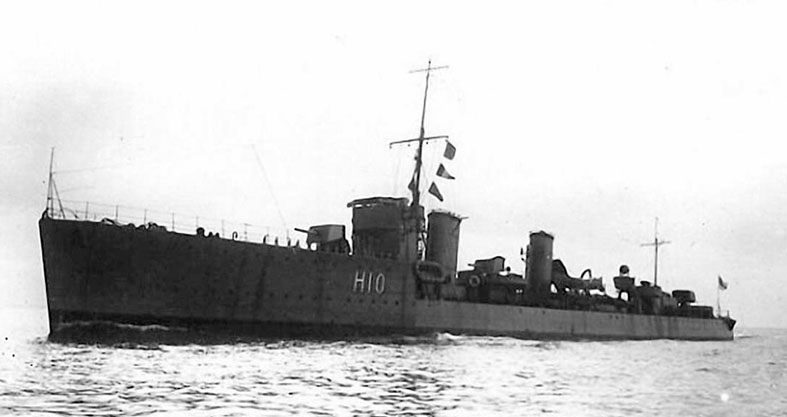
HMS Umpire, the destroyer with the H10 pennant number,
which rescued Mrs Huggins and her family
Courtesy of Terry Dickens
The accident and its aftermath are described on the web site of Veterans Aid:
“Mrs Huggins, on her return to England and mindful of the miracle that had saved her husband, her son and herself from drowning, prayed daily that some work which needed doing might be shown to her. However, none of the projects which came her way appealed and it was not until 1930 when, on visits to London, she was stopped frequently by down and out ex-Service men asking for help, that a scheme to help them began to formulate in her mind.
A canteen and recreation room for destitute ex-Service men was opened at Belvedere Road, Lambeth, London SE1, in January 1932 and named H10 after HMS Umpire, the ship which saved their lives. Additional accommodation was obtained, a hostel opened and a night shelter established in co-operation with other societies and in 1933, the title Embankment Fellowship Centre was adopted. During the Winter of 1934-35, the Fellowship provided 23, 091 nights of shelter and 53,382 meals for destitute former Service men.”
Gwen Huggins may not have known the name of the ship which rescued her family but the pennant number H10 clearly visible painted on the hull would have identified it. The H (flag superior) identified it as a destroyer and the 10 (flag inferior) as being HMS Umpire, an R Class destroyer. HMS Umpire was built in 1917 but sold for breaking up in 1930 and once it was scrapped it must have seen sensible to change the name of the hostel to the Embankment Fellowship Centre. The next ship to bear the name HMS Umpire was a U-Class submarine launched on 30 December 1940 and sunk in an accident nine days after commissioning. The name has not been used since. The charity now renamed Veterans Aid is still active today.

Led to the founding of the charity H10, now known as Veterans Aid

A peacetime photograph from the 1920s (note the sun canopies fore and aft) of HMS Venomous moored in Vittoriosa Creek on the opposite side of the Grand Harbour from Valletta
Malta was the centre of naval operations in the Mediterranean and the Admiral of the Mediterranean Fleet had his headquarters in Vittoriosa
The building with the clock tower on the right was the naval bakery and is now the Malta Maritime Museum - note the traditional Dghaisa moored in foreground.
This postcard is reproduced courtesy of Ralph Ayre, grandson of PO Billy Walton of HMS Venomous, 1944-6
Malta was the centre of naval operations in the Mediterranean and the Admiral of the Mediterranean Fleet had his headquarters in Vittoriosa
The building with the clock tower on the right was the naval bakery and is now the Malta Maritime Museum - note the traditional Dghaisa moored in foreground.
This postcard is reproduced courtesy of Ralph Ayre, grandson of PO Billy Walton of HMS Venomous, 1944-6
Ladies and gentlemen strolling along the ramparts overlooking the Grand Harbour on a Sunday afternoon in November 1924 would have had a grandstand view of events as HMS Venomous rammed and sunk a motor boat taking Major Charles Huggins and his wife and eleven year old son to the cruiser HMS Calypso for afternoon tea.
HMS Venomous with Lt Cdr Donal Scott McGrath RN in command left Gibraltar on Thursday 30 October at 1924 and entered the Grand Harbour at Valetta on the afternoon of Sunday 2 November. A brief entry in the Logbook recorded what happened:
1630 Slow course as req. for entering harbour
1634 ˝ Rammed & sank MB belonging to “Calypso”. All hands saved.
1650 Secured alongside “Woolston” at Canteen Wharf
An entry in the log book of HMS Calypso, a light cruiser of the Mediterranean Fleet, for 2 November 1924 reads:
16.35 hours. Motor boat sunk in collision with Venomous, lowered boats and rescued crew.

 The four
passengers were Major Charles Gilbert Dingwall Huggins (1882-1965), second-in-command of the Gordon
Highlanders stationed at Malta, his wife Gwendolen Isla Huggins, neé Brougham (1892-1974), their eleven
year old son Ulric, and Lieutenant (later Captain) Cronyn RN, who had
invited the Huggins
family to tea on Calypso. The
passengers embarked at Custom House Steps, Valletta, the adults
sheltering from the hot sun under the old fashioned painted canopy.
The four
passengers were Major Charles Gilbert Dingwall Huggins (1882-1965), second-in-command of the Gordon
Highlanders stationed at Malta, his wife Gwendolen Isla Huggins, neé Brougham (1892-1974), their eleven
year old son Ulric, and Lieutenant (later Captain) Cronyn RN, who had
invited the Huggins
family to tea on Calypso. The
passengers embarked at Custom House Steps, Valletta, the adults
sheltering from the hot sun under the old fashioned painted canopy.While crossing the Grand Harbour, the boat heeled sharply as HMS Venomous approached. Lieutenant Cronyn moved quickly to the stern sheets and saw immediately that disaster threatened. He shouted a warning to Major and Mrs Huggins and threw Ulric overboard as the boat was rammed amidships, turned over and sank.
Ulric was carried clear of the destroyer by its bow wave and supported by the Gordon kilt he was wearing. Lieutenant Cronyn was sucked under the vessel but being a strong swimmer got clear, and always remembered the horrified look of the first lieutenant on the bridge of Venomous. Major Huggins went down with the boat but surfaced in a near drowning condition. The cox’n and his stoker jumped overboard and swam clear. This fine portrait of Ulric was painted in 1925.
HMS Umpire, a modified R-Class destroyer with the pennant number H10 on its side (see photograph below), lowered its boat and rescued passengers and crew.
Mrs Huggins failed to get clear of the canopy and found herself trapped in the wreckage but able to breathe due to an air-pocket in a bulge of the canopy. She freed her leg from an obstruction; launched herself clear and saw blackness give way to violet, then to blue and finally a green diffused light before shooting out of the water waist high into the brightness of day. A cry went up “there she is” and she was quickly hauled out of the water. She had been at the bottom of the harbour in 12 fathoms for about 10 minutes. Remarkably she suffered no ill-effects from her ordeal and insisted on walking up the companionway of Calypso unassisted.
The most detailed account of the near fatal accident was that given in The Daily Malta Chronicle
 The young wife of Lt Cdr Donal Scott McGrath RN (on left, 1915), the CO of HMS Venomous,
pasted this press cutting into the pages of her scrapbook about the
naval career of her husband. It was sent to me by their grandson in
Australia.
The young wife of Lt Cdr Donal Scott McGrath RN (on left, 1915), the CO of HMS Venomous,
pasted this press cutting into the pages of her scrapbook about the
naval career of her husband. It was sent to me by their grandson in
Australia. "At about 4.25 pm on Sunday last, HMS Venomous after entering the Grand Harbour was proceeding to her mooring. At the same time the pickett boat of HMS Calypso had just left the Custom House steps, conveying Major C.G.D. Huggins Gordon Highlanders, Mrs Huggins and child onboard the Calypso where they had been invited to tea by the Officers of that ship.
The coxwain attempted to cross the bows of the Venomous, which was proceeding at the usual speed to her moorings, and, it is surmised, he either misjudged his distance or the speed of the destroyer with the result that the sharp bow of the destroyer cut the Pickett-Boat amidships sinking her rapidly. Amost simultaneously with the collision, the engines of the Venomous were stopped, life-buoys were thrown in the direction of the accident, while several of the crew jumped overboard to render assistance. Major and Mrs Huggins and the child were at the time in the small cabin aft and so rapidly did the boat sink that Mrs Huggins had no time to rush out and was carried down with the wreck, still imprisoned in the cabin. Be it said to the credit of the "dghaisa" boatmen, within a few seconds of the accident a number of dghaisas were on the spot having rushed at once. Major Huggins and his wife were picked out of the water by the dghaisa men , together with the crew of the Pickett-boat but in spite of all search Mrs Huggins could not be found.
Meanwhile the Water Police Motor Boat under the charge of Inspector Lopez and 1st class Sergeant Darmanin, and the Customs House Steam Launch were on the spot together with the boats hastily lowered from HMS Calypso, in the vicinity of which destroyer the accident had taken place. Major Huggins being unconscious was together wth his son, conveyed by the boatmen on board HMS Calypso, while the crew of the wrecked boat, who were none the worse for the accident, were transhipped from the dghaisas to the whaler of HMS Calypso. The whole thing happened so quickly and everybody acted so swiftly and energetically that it is almost impossible to give an adequate description of all the different events happening simultaneously.
As all the occupants of the wrecked boat were picked up and sent on board, the efforts of the dghaisa boatmen, Police and Calypso boats and Custom House launch were directed to the search of Hrs Huggins, who, it was known, had gone down with the wrecked boat. But minutes of feverish rowing round and anscious peering below the surface passed and still no sign of the missing lady. It was only after an interval reckoned by eye-witnesses as between 7 and 10 minutes that Mrs Huggins shot up to the surface, and was at once picked up by Inspector Lopez and Sergeant Darmanin on board the Water Police Motor Boat. Strange as it may appear, Mrs Huggins, after such a lengthy immersion was not unconscious, and as soon as she was lain down on blankets in the Police boat she, she ansciously asked: "Where is my husband? What happened to my child?" And would not rest till she was assured that both were safe and already on board the Calypso, to which ship the lady was swiftly conveyed by the Motor Boat. As at the same time the Medical Officer of the Calypso was not onboard, the same boat went and fetched a doctor from HMS Iron Duke. Major Hugggins was found to be suffering from shock and by order of the Medical Officer was remitted to the Imtarfa Military Hospital in an ambulance. All the others are safe and well."
The coxwain attempted to cross the bows of the Venomous, which was proceeding at the usual speed to her moorings, and, it is surmised, he either misjudged his distance or the speed of the destroyer with the result that the sharp bow of the destroyer cut the Pickett-Boat amidships sinking her rapidly. Amost simultaneously with the collision, the engines of the Venomous were stopped, life-buoys were thrown in the direction of the accident, while several of the crew jumped overboard to render assistance. Major and Mrs Huggins and the child were at the time in the small cabin aft and so rapidly did the boat sink that Mrs Huggins had no time to rush out and was carried down with the wreck, still imprisoned in the cabin. Be it said to the credit of the "dghaisa" boatmen, within a few seconds of the accident a number of dghaisas were on the spot having rushed at once. Major Huggins and his wife were picked out of the water by the dghaisa men , together with the crew of the Pickett-boat but in spite of all search Mrs Huggins could not be found.
Meanwhile the Water Police Motor Boat under the charge of Inspector Lopez and 1st class Sergeant Darmanin, and the Customs House Steam Launch were on the spot together with the boats hastily lowered from HMS Calypso, in the vicinity of which destroyer the accident had taken place. Major Huggins being unconscious was together wth his son, conveyed by the boatmen on board HMS Calypso, while the crew of the wrecked boat, who were none the worse for the accident, were transhipped from the dghaisas to the whaler of HMS Calypso. The whole thing happened so quickly and everybody acted so swiftly and energetically that it is almost impossible to give an adequate description of all the different events happening simultaneously.
As all the occupants of the wrecked boat were picked up and sent on board, the efforts of the dghaisa boatmen, Police and Calypso boats and Custom House launch were directed to the search of Hrs Huggins, who, it was known, had gone down with the wrecked boat. But minutes of feverish rowing round and anscious peering below the surface passed and still no sign of the missing lady. It was only after an interval reckoned by eye-witnesses as between 7 and 10 minutes that Mrs Huggins shot up to the surface, and was at once picked up by Inspector Lopez and Sergeant Darmanin on board the Water Police Motor Boat. Strange as it may appear, Mrs Huggins, after such a lengthy immersion was not unconscious, and as soon as she was lain down on blankets in the Police boat she, she ansciously asked: "Where is my husband? What happened to my child?" And would not rest till she was assured that both were safe and already on board the Calypso, to which ship the lady was swiftly conveyed by the Motor Boat. As at the same time the Medical Officer of the Calypso was not onboard, the same boat went and fetched a doctor from HMS Iron Duke. Major Hugggins was found to be suffering from shock and by order of the Medical Officer was remitted to the Imtarfa Military Hospital in an ambulance. All the others are safe and well."
It is interesting to note that the report is careful to mention that HMS Venomous was entering the Grand Harbour "at the usual speed" and understandably gives most of the credit to the local men in the Water Police Launch and to the Dghaisa men but it is puzzling that it fails to make any mention of HMS Umpire which was credited by Mrs Huggins with saving her life and that of her family and led to the founding of a well known charity still active today - see below.

HMS Calypso, a Caledon Class Light Cruiser built in 1917,
leaving the Grand Harbour with Fort Ricasoli in the background
In 1922 it rescued the Greek royal family after a military junta seized power.
Prince Philip, the future Duke of Edinburgh, was famously taken aboard in a cot made from an orange box.
Courtesy of Terry Dickens

HMS Umpire, the destroyer with the H10 pennant number,
which rescued Mrs Huggins and her family
Courtesy of Terry Dickens
The accident and its aftermath are described on the web site of Veterans Aid:
“Mrs Huggins, on her return to England and mindful of the miracle that had saved her husband, her son and herself from drowning, prayed daily that some work which needed doing might be shown to her. However, none of the projects which came her way appealed and it was not until 1930 when, on visits to London, she was stopped frequently by down and out ex-Service men asking for help, that a scheme to help them began to formulate in her mind.
A canteen and recreation room for destitute ex-Service men was opened at Belvedere Road, Lambeth, London SE1, in January 1932 and named H10 after HMS Umpire, the ship which saved their lives. Additional accommodation was obtained, a hostel opened and a night shelter established in co-operation with other societies and in 1933, the title Embankment Fellowship Centre was adopted. During the Winter of 1934-35, the Fellowship provided 23, 091 nights of shelter and 53,382 meals for destitute former Service men.”
Gwen Huggins may not have known the name of the ship which rescued her family but the pennant number H10 clearly visible painted on the hull would have identified it. The H (flag superior) identified it as a destroyer and the 10 (flag inferior) as being HMS Umpire, an R Class destroyer. HMS Umpire was built in 1917 but sold for breaking up in 1930 and once it was scrapped it must have seen sensible to change the name of the hostel to the Embankment Fellowship Centre. The next ship to bear the name HMS Umpire was a U-Class submarine launched on 30 December 1940 and sunk in an accident nine days after commissioning. The name has not been used since. The charity now renamed Veterans Aid is still active today.
A rather charming ten minute film, Smith, made by Michael Powell in 1939 can also be seen.
The charity now renamed Veterans Aid is still active today.
Find out how you can help
The charity now renamed Veterans Aid is still active today.
Find out how you can help
What happened to young Ulric?
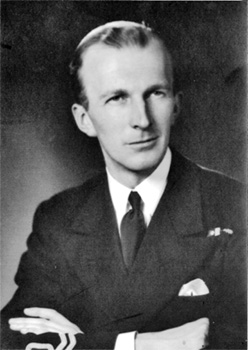
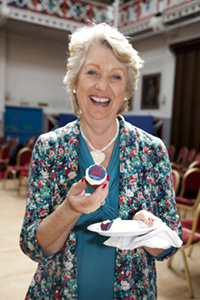 Eleven year old Ulric never swam again after his baptism in the Grand Harbour at Valletta but despite his fear of water Ulric Gilbert Brougham Lang Huggins served as a wartime gunnery officer in the
Royal Navy. As chance would have it he was a sub lieutenant on HMS Caradoc when her identical sister ship, HMS Calypso, was sunk by an Italian submarine in June 1940, the first Royal Navy warship to be sunk by the Italian Navy in the war.
Eleven year old Ulric never swam again after his baptism in the Grand Harbour at Valletta but despite his fear of water Ulric Gilbert Brougham Lang Huggins served as a wartime gunnery officer in the
Royal Navy. As chance would have it he was a sub lieutenant on HMS Caradoc when her identical sister ship, HMS Calypso, was sunk by an Italian submarine in June 1940, the first Royal Navy warship to be sunk by the Italian Navy in the war.
He had a second narrow escape on the 8 March 1941 when dining with his first wife, Patricia M. Cole, and two friends, a Belgian doctor and an Austrian nurse, at the Café de Paris during the blitz. The Café de Paris, one of the smartest and most fashionable venues in London, was located in a basement beneath the Rialto Cinema just off Leicester Square and was believed to be almost impregnable but just after 9.30 pm as Ken 'Snakehips' Johnson and The West Indian Orchestra were striking up 'Oh Johnnie' two 50 kg bombs pierced the cinema roof and ended up on the dance floor. "One exploded at head height killing Johnson and 33 others. A waiter standing behind Huggins and serving him champagne as the bomb exploded was killed by a shaft of glass in the back; miraculously Huggins and his party survived unscathed. The Belgian doctor provided medical aid while the others brought survivors to him for attention." Ulric was a good friend of Peter Danckwerts, wartime naval bomb disposal expert and brilliant post war chemical engineer (the Shell Department of Chemical Engineering at the University of Cambridge), and this story is told by his biographer, Peter Varey, in 'Life on the Edge: Peter Danckwerts GC MBE FRS'.
Lt U.G.B.L. Huggins RNVR (1913 - 2001) was Mentioned in Despatches while serving on HMS Aurora in December 1942. He married a WREN, Una Patricia Lennard, and they had a daughter, Janie Huggins. After the war Ulric Huggins worked for Shell and on retirement became a Director of the charity, the Muscular Dystrophy Campaign. Janie Huggins (left) only recently discovered the part her family played in the founding of Veterans Aid and was a welcome guest at the Charity's AGM at the Headquarters of the London Scottish Regiment in 2014 where she was photographed holding a cupcake bearing the logo of the charity founded by her grandmother.

 Eleven year old Ulric never swam again after his baptism in the Grand Harbour at Valletta but despite his fear of water Ulric Gilbert Brougham Lang Huggins served as a wartime gunnery officer in the
Royal Navy. As chance would have it he was a sub lieutenant on HMS Caradoc when her identical sister ship, HMS Calypso, was sunk by an Italian submarine in June 1940, the first Royal Navy warship to be sunk by the Italian Navy in the war.
Eleven year old Ulric never swam again after his baptism in the Grand Harbour at Valletta but despite his fear of water Ulric Gilbert Brougham Lang Huggins served as a wartime gunnery officer in the
Royal Navy. As chance would have it he was a sub lieutenant on HMS Caradoc when her identical sister ship, HMS Calypso, was sunk by an Italian submarine in June 1940, the first Royal Navy warship to be sunk by the Italian Navy in the war.He had a second narrow escape on the 8 March 1941 when dining with his first wife, Patricia M. Cole, and two friends, a Belgian doctor and an Austrian nurse, at the Café de Paris during the blitz. The Café de Paris, one of the smartest and most fashionable venues in London, was located in a basement beneath the Rialto Cinema just off Leicester Square and was believed to be almost impregnable but just after 9.30 pm as Ken 'Snakehips' Johnson and The West Indian Orchestra were striking up 'Oh Johnnie' two 50 kg bombs pierced the cinema roof and ended up on the dance floor. "One exploded at head height killing Johnson and 33 others. A waiter standing behind Huggins and serving him champagne as the bomb exploded was killed by a shaft of glass in the back; miraculously Huggins and his party survived unscathed. The Belgian doctor provided medical aid while the others brought survivors to him for attention." Ulric was a good friend of Peter Danckwerts, wartime naval bomb disposal expert and brilliant post war chemical engineer (the Shell Department of Chemical Engineering at the University of Cambridge), and this story is told by his biographer, Peter Varey, in 'Life on the Edge: Peter Danckwerts GC MBE FRS'.
Lt U.G.B.L. Huggins RNVR (1913 - 2001) was Mentioned in Despatches while serving on HMS Aurora in December 1942. He married a WREN, Una Patricia Lennard, and they had a daughter, Janie Huggins. After the war Ulric Huggins worked for Shell and on retirement became a Director of the charity, the Muscular Dystrophy Campaign. Janie Huggins (left) only recently discovered the part her family played in the founding of Veterans Aid and was a welcome guest at the Charity's AGM at the Headquarters of the London Scottish Regiment in 2014 where she was photographed holding a cupcake bearing the logo of the charity founded by her grandmother.
Follow
in the wake of HMS Venomous
on this web site
Venomous played an important part in Operation Pedestal which broke the Axis blockade of the “George Cross Island” in 1942

Holywell House Publishing
88 Holywell Hill, St
Albans, Hertfordshire AL1 1DH, Britain
http://holywellhousepublishing.co.uk
Telephone: +44 1727 838595
contact online
http://holywellhousepublishing.co.uk
Telephone: +44 1727 838595
contact online






